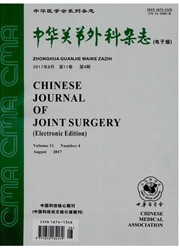

 中文摘要:
中文摘要:
目的探讨纳米羟基磷灰石/重组胶膨聚乳酸(nano-hydroxyapatite/recombinanthuman-like collagen/polylactic acid,nHA/RHLC/PLA)复合多孔支架材料作为骨形态发生蛋白2(Bonemorphogenetic protein2,BMP2)活性多肽载体的可行性。方法制备nHA/RHLC/PLA复合多孔支架材料,扫描电镜观察支架材料表面微观形貌;通过真空吸附法将BMP2活性多肽与支架材料复合,采用高效液相色谱仪检测不同时问点BMP2活性多肽的释放量,观察BMP2活性多肽的体外释放规律;将复合了BMP2活性多肽的支架材料作为实验组,未复合BMP2活性多肽的支架材料作为对照组,分别植入大鼠背部肌肉内,于4周和8周两个时间点将大鼠分批处死,进行CT扫描、三维重建和组织学观察。结果扫描电镜结果显示:支架材料表面呈多孔状;体外BMP2活性多肽释放规律为:第1d表现为爆发性释放释放量为35.5%,以后缓慢持续释放,至1个月左右释放量达89.6%;CT扫描、三维重建和组织学观察结果均表明复合了BMP2活性多肽的多孔支架材料有较多新生骨组织形成,对照组未见成骨现象。结论nHA/RHLC/PLA复合多孔支架材料可以作为BMP2活性多肽的缓释载体,负载BMP2活性多肽的nHA/RHLC/PLA是一种理想的骨组织工程支架材料。
 英文摘要:
英文摘要:
Objective To investigate the feasibility of nano-hydroxyapatite/reeombinant humanlike eollagen/polylaetic acid (nHA/RHLC/PLA) as carrier for sustained release of BMP2-derived peptide. Methods nHA/RHLC/PLA was prepared by themal-induced method and observed with scanning electron microscope. The BMP2-derived peptide was introduced through a method of vacuum sorption. For observing the releasing character of BMP2-derived peptide, the released peptide content from the scaffold was detec- ted using high performance liquid chromatography at different set times. The scaffold loading with BMP2- derived peptide as the experimental group and the scaffold without BMP2-derived peptide as control group were respectively implanted into the muscle of back of rats. Up to 4th , 8th and 12th week after implanta- tion, the rats were killed in batch, and the samples were harvested and detected by CT scan, three-dimen-sional reconstruction of computed tomography and histological observation. Results The results of scan- ning electron microscope showed that the surface of the scaffold was porous. The releasing character of BMP2-defived was that an initial burst releasing (35. 5% ) was observed over the first day, followed by a sustained release and reached 89. 6% at one month. The results of CT scan, three-dimensional reconstruc- tion of computed tomography, and histological observation showed that new bone was formed in the experimental group hut there was no bone formation in the control group. Conclusion The porous nHA/ RHLC/PLA can be served as carrier for sustained release of BMP2-derived peptide and the scaffold loading with BMP2-derived peptide is a kind of ideal scaffold material for bone tissue engineering.
 同期刊论文项目
同期刊论文项目
 同项目期刊论文
同项目期刊论文
 期刊信息
期刊信息
